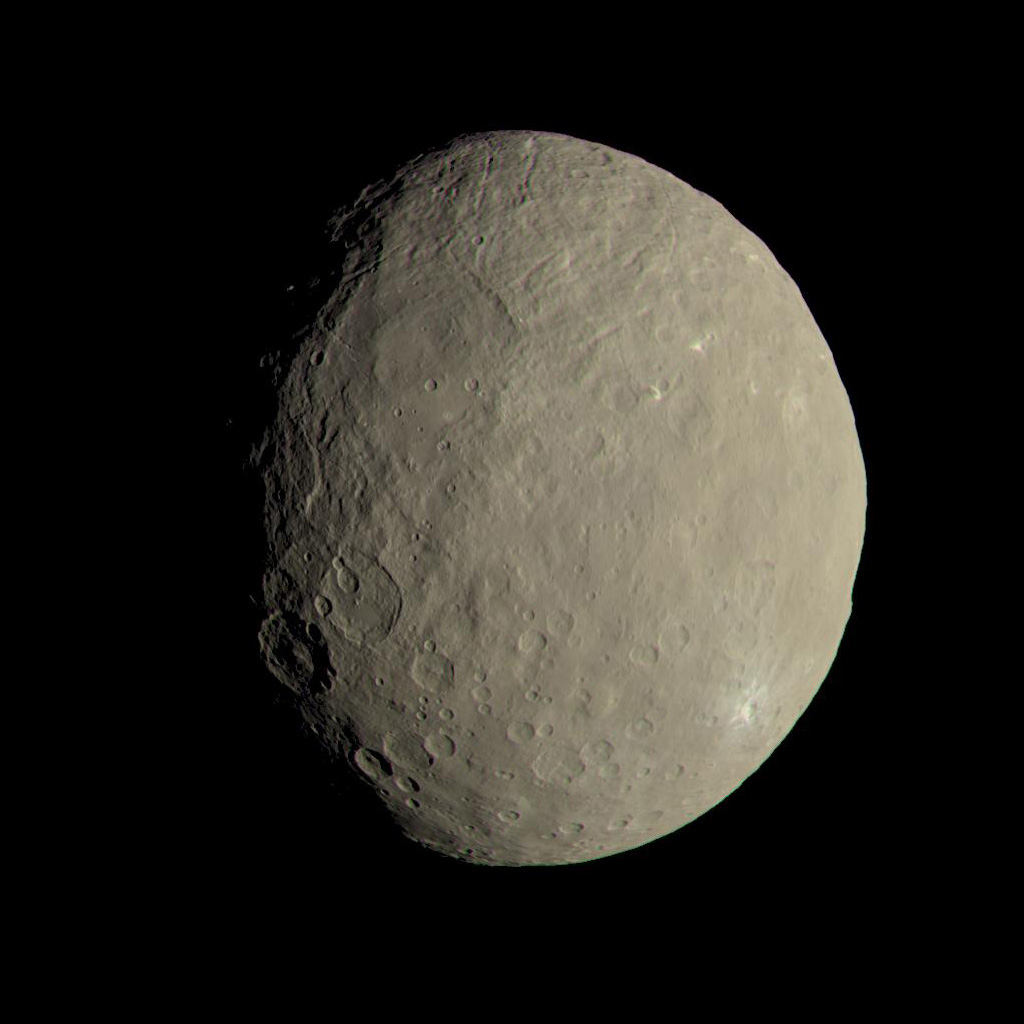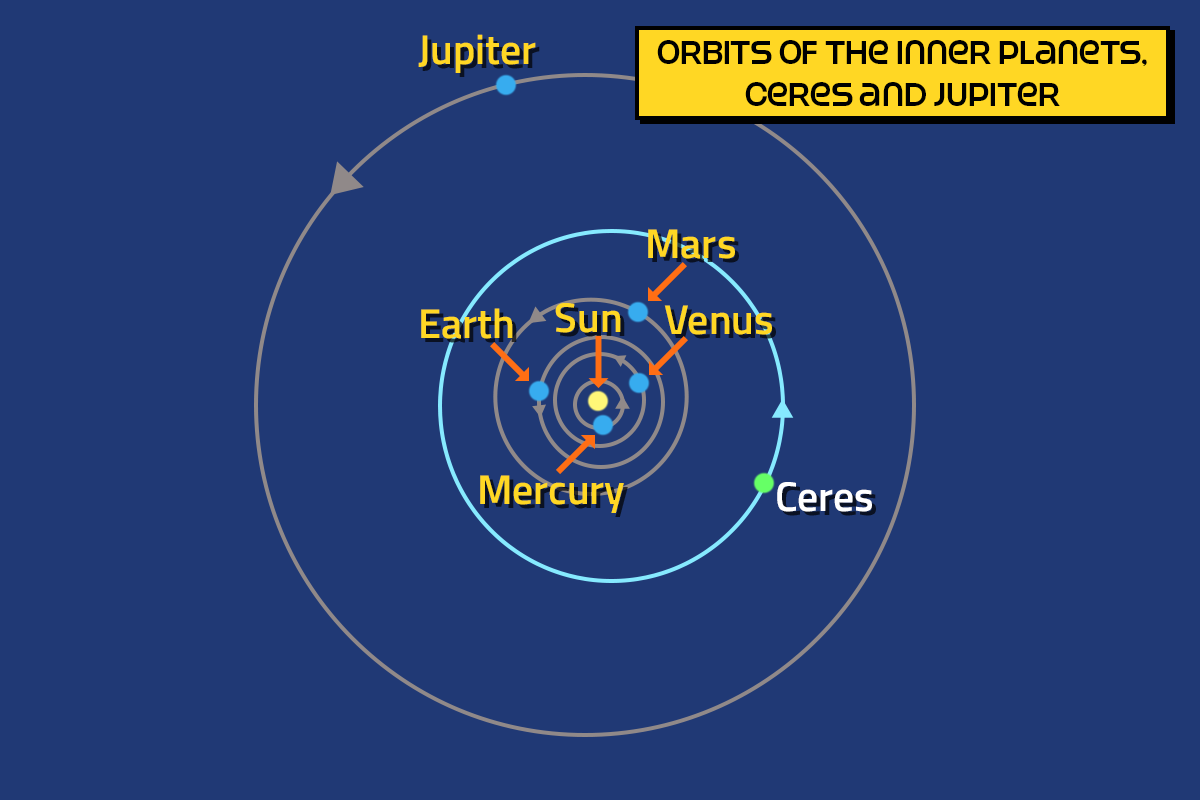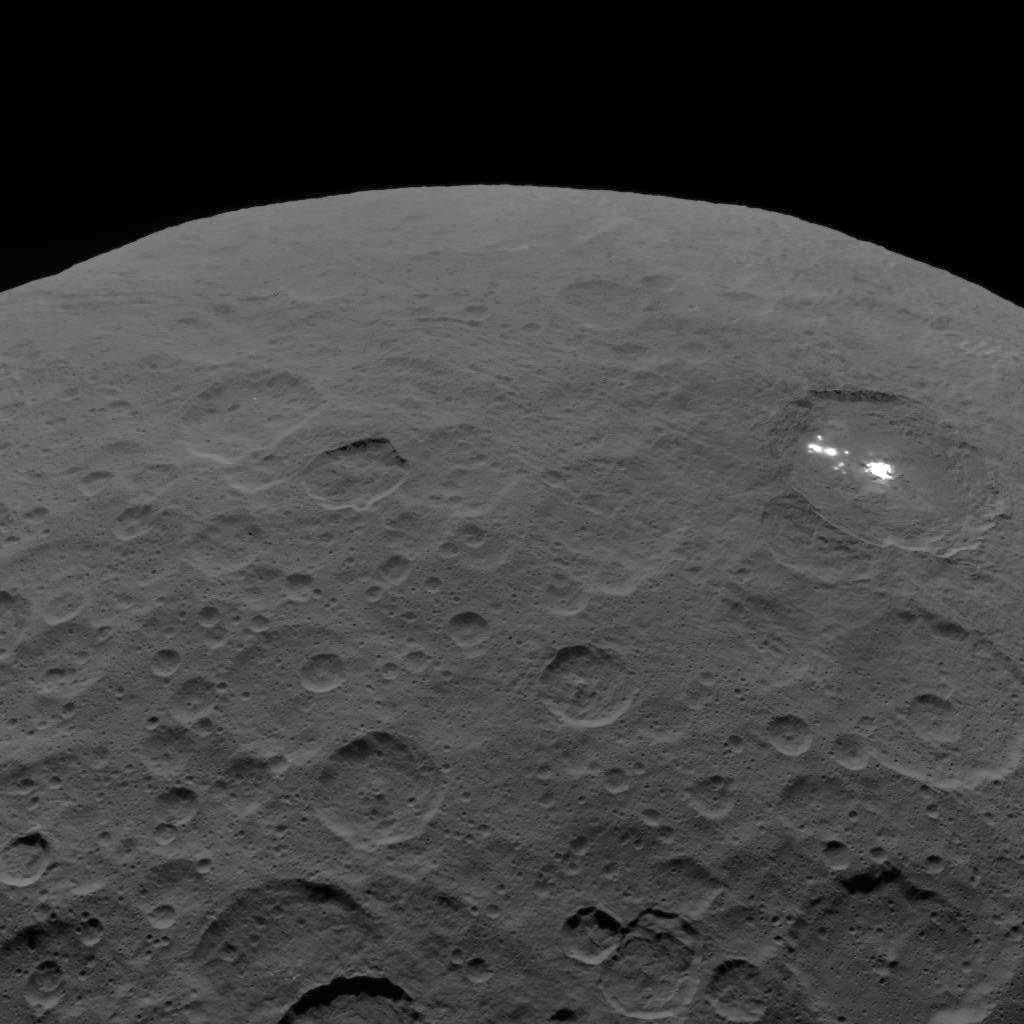Welcome to Ceres!
Ceres is a dwarf planet that was discovered in 1801 by the Italian astronomer Guiseppi Piazzi. It is situated in the asteroid belt between the orbits of the planets Mars and Jupiter. Ceres is the largest object in the asteroid belt and was once considered to be a planet. It was later reclassified as an asteroid before getting re-reclassified as a dwarf planet in 2006. Who knows what it'll be in the future? A tennis ball perhaps? Or maybe a hippopotamus? Ceres has been visited by one spacecraft. That was Dawn which took in its majestic sights between 2015 and 2018.
 Ceres as imaged by the Dawn spacecraft in 2015. This is a combinations of images which attempt to show the true colour of Ceres. Image credit: NASA/JPL-Caltech/UCLA/MPS/DLR/IDA
Ceres as imaged by the Dawn spacecraft in 2015. This is a combinations of images which attempt to show the true colour of Ceres. Image credit: NASA/JPL-Caltech/UCLA/MPS/DLR/IDA
2,574,097,718 miles
2.77 A.U.
583 miles
-159 °F
Ceres orbits in a region of the solar system called the asteroid belt. The asteroid belt is situated between the orbits of Mars and Jupiter and contains millions of rocks called asteroids. These asteroids vary in size - most are small odd-shaped rocks, but others are much larger. Ceres is by far the largest object in the area and contains 25% of the entire mass of the asteroid belt.

Some scientists believe that the objects in the asteroid belt are the ingredients of a planet that didn't quite make it. In the early solar system, the planets formed by rocks joining with other rocks until they became large enough to become ball-shaped and had gobbled up all of the objects in their path. For whatever reason, the objects in the asteroid belt didn't do this. This might be because there simply aren't enough rocks in the asteroid belt to form a planet, and they are too far apart to be attracted and join with each other.
As the largest object in the asteroid belt, Ceres is the one that came closest to becoming a planet. But even though it's the largest, it is still small when compared with other objects in the solar system. With a diameter of 939 kilometres (583 miles), it is about a fifth of the width of the solar system's smallest planet Mercury (4,879 km/3,032 miles), one thirteenth the width of Earth (12,742 km/7,918 miles) and a quarter the size of the Moon (3,475 km/2,159 miles).
Ceres takes 4 years and 222 days to complete an orbit of the Sun. As a comparison with its nearest planets, Mars takes 687 days to get around the Sun, and Jupiter takes 11 years and 314 days.

In 1781, twenty years before Ceres was discovered, the planet Uranus was discovered by the English astronomer William Herschel. Before then, people thought that the solar system contained only six planets - Mercury, Venus, Earth, Mars, Jupiter and Saturn. These had been known since ancient times because they are easily visible. Uranus became the solar system's first newly discovered planet and led astronomers to believe that there may be even more out there. They calculated that a likely location would be in the vast space between Mars and Jupiter's orbits. A group of European astronomers formed the Celestisal Police. Their mission was to find a planet in that gap.
The Italian priest and astronomer Guiseppi Piazzi was invited to join the group, but managed to find the missing planet before he even received his invitation! On 1st January 1801, while attempting to make observations of a known star, he spotted a dim unknown object instead. Over the next few nights, he made further observations of the object, noticing how it moved across the sky. This confirmed to him that he wasn't looking at a star. He initially thought that it might be a comet but its movement was too slow for it to be one. Undoubtedly excited that he might have discovered a planet, he wrote to fellow astronomers and his findings were published later that year. The new object became difficult to see for a while due to its position in the sky but on the very last day of 1801, it was found again by two other members of the Celestial Police, Hungarian astronomer Franz Xaver von Zach and German astronomer Heinrich W. M. Olbers.
Ceres is named after the Roman goddess of agriculture, grain, fertility and the love of a mother for her child. Its name was partially picked by its discoverer, Guiseppi Piazzi. He wanted to give it the full name Ceres Ferdinandea. The Ferdinandea part was meant to be in honour of the ruler of Sicily, King Ferdinand III. Astronomers in different countries didn't really like the idea of naming planets after Kings or Queens of other countries, so Ferdinandea was dropped and it was referred to as Ceres alone. William Herschel tried the same idea when he attempted to name Uranus in honour England's ruler, King George I.
For a while before being seen again towards the end of 1801, some astronomers referred to the object as Juno or Hera, wife and sister of Jupiter/Zeus. At the time of its naming, Ceres was the second planet to be named after a female. The first is Venus, the goddess of love and beauty. Although Ceres later lost its status as a planet, it retained its name. Its formal name is 1 Ceres, the 1 referring to it being the first object of its type to be discovered.
Since its discovery in 1801, Ceres has had multiple identities. Although its discoverer Guiseppi Piazzi briefly thought that he'd discovered a comet when he first spotted it, he quickly came to realise that his new object probably wasn't one. Astronomers expected that a planet would exist somewhere between Mars and Jupiter, and when Ceres was discovered in that gap, there was no question about it - Ceres had to be a planet.
In the years following the discovery of Ceres, members of the Celestial Police discovered three more objects in the same gap. Pallas was discovered in 1802, Juno in 1804 and Vesta in 1807. Like Ceres, these all became recognised as planets, meaning that the solar system was now considered to have eleven: Mercury, Venus, Earth, Mars, Vesta, Juno, Ceres, Pallas, Jupiter, Saturn and Uranus. Imagine coming up with a sentence to memorise their order! It could be something like My Very Energetic Mother Vaults Carefully Past Joyful Shiny Unicorns.
Following a quiet few decades (the Celestial Police were probably arresting stars or something), discoveries of more objects between the orbits of Mars and Jupiter began again from 1845. Between then and 1860, astronomers discovered over 50 more objects in that patch of the solar system. It was becoming impractical to recognise them all as planets as most were small and insignificant so they began being referred to as asteroids instead. This included the earlier discoveries like Ceres. The word asteroid had been invented earlier by William Herschel to describe an object with a star-like appearance. The region between Mars and Jupiter became the asteroid belt.
By 2005, the solar system was now considered to have nine planets: Mercury, Venus, Earth, Mars, Jupiter, Saturn and Uranus, plus Neptune which had been discovered in 1846 and Pluto which was discovered in 1930. At the time, Pluto was recognised as the most distant planet in the solar system, orbiting in a region beyond Neptune called the Kuiper Belt. It became clear that Pluto wasn't alone in its distant orbit. There were many other objects in that region too, including one that was of a similar size to Pluto. It was discovered in 2005 and was later given the name Eris. As Eris was one of potentially hundreds or thousands of similar objects, astronomers didn't really want to recognise it as a planet. Instead, in 2006, they had a meeting and invented a new classification - the dwarf planet. This led to Eris being recognised as a Dwarf Planet and Pluto being reclassified as one. Poor Pluto.
A dwarf planet describes an object which is massive enough to be mostly spherical and which orbits the Sun, but which hasn't cleared its region of other objects. As Ceres also meets this description, it meant that it too could be reclassified. And that explains why Ceres is now a dwarf planet. The End.
If you really want to confuse yourself, Ceres can also be recognised as a minor planet.
In 2015, the spacecraft Dawn reached Ceres and entered into an orbit of the little world, remaining there until 2018. Dawn was the first spacecraft to make observations of objects in the Asteroid Belt and also the first to reach a dwarf planet. It was launched from Cape Canaveral on 27th September 2007. Prior to visiting Ceres, it made a trip to the asteroid Vesta, spending much of 2011 and 2012 in its orbit.
Dawn made lots of observations of Ceres, and sent back images showing bright spots on its surface inside craters. These bright spots are believed to be regions of salt, and there's a possibility that below the thick frozen outer crust of Ceres is a sludge of rock, mud, salt and water. The salt visible on its surface might be the result of meteorites colliding into Ceres, fracturing its outer crust and allowing some of its slushy salty insides to froth up to its surface.

Dawn also discovered evidence of organic materials on the surface of Ceres. Organic materials are created naturally through chemical reactions, sometimes by lifeforms but not always. Scientists don't really know of the origins of the organic materials on Ceres. But the presence of it, as well as water below its surface, means that Ceres might not be an impossible place for very basic life to exist.
Dawn's mission ended at the end of October 2018 when it ran out of fuel. Because of the discovery of water and organic materials on Ceres, it was placed into an orbit which would prevent it from crashing into its surface and potentially contaminating the dwarf planet for at least twenty years. The spacecraft is now inactive but remains in orbit of Ceres.





